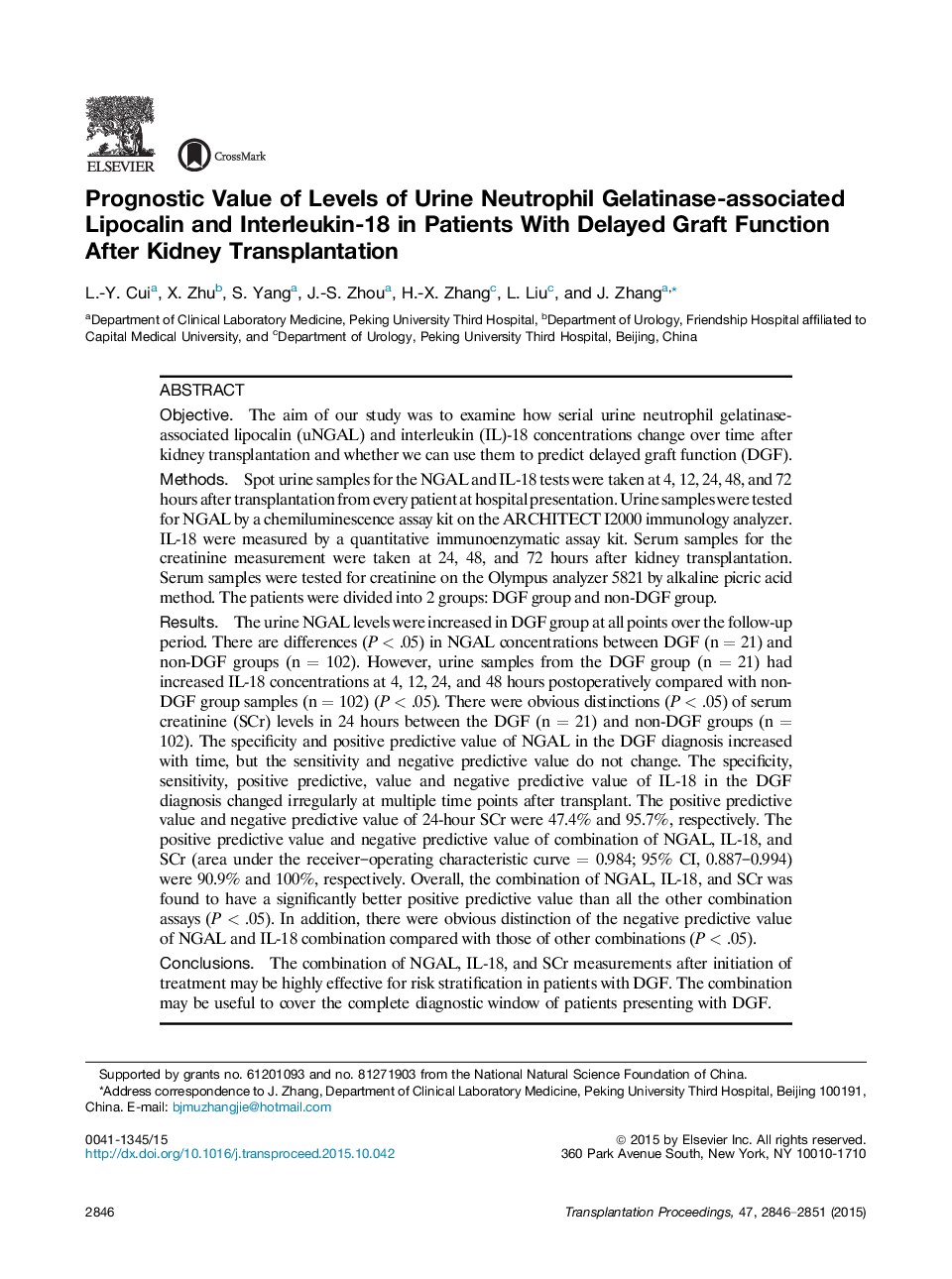| کد مقاله | کد نشریه | سال انتشار | مقاله انگلیسی | نسخه تمام متن |
|---|---|---|---|---|
| 4255831 | 1284500 | 2015 | 6 صفحه PDF | دانلود رایگان |
• There is a relationship between urine NGAL, IL-18 concentration, and DGF after kidney transplantation.
• NGAL and IL-18 need to be investigated as potential early markers for DGF, especially in the setting of early dialysis treatment or antirejection therapy.
• Randomization to a treatment for DGF based on high biomarker levels results in an improvement in clinical outcomes.
ObjectiveThe aim of our study was to examine how serial urine neutrophil gelatinase-associated lipocalin (uNGAL) and interleukin (IL)-18 concentrations change over time after kidney transplantation and whether we can use them to predict delayed graft function (DGF).MethodsSpot urine samples for the NGAL and IL-18 tests were taken at 4, 12, 24, 48, and 72 hours after transplantation from every patient at hospital presentation. Urine samples were tested for NGAL by a chemiluminescence assay kit on the ARCHITECT I2000 immunology analyzer. IL-18 were measured by a quantitative immunoenzymatic assay kit. Serum samples for the creatinine measurement were taken at 24, 48, and 72 hours after kidney transplantation. Serum samples were tested for creatinine on the Olympus analyzer 5821 by alkaline picric acid method. The patients were divided into 2 groups: DGF group and non-DGF group.ResultsThe urine NGAL levels were increased in DGF group at all points over the follow-up period. There are differences (P < .05) in NGAL concentrations between DGF (n = 21) and non-DGF groups (n = 102). However, urine samples from the DGF group (n = 21) had increased IL-18 concentrations at 4, 12, 24, and 48 hours postoperatively compared with non-DGF group samples (n = 102) (P < .05). There were obvious distinctions (P < .05) of serum creatinine (SCr) levels in 24 hours between the DGF (n = 21) and non-DGF groups (n = 102). The specificity and positive predictive value of NGAL in the DGF diagnosis increased with time, but the sensitivity and negative predictive value do not change. The specificity, sensitivity, positive predictive, value and negative predictive value of IL-18 in the DGF diagnosis changed irregularly at multiple time points after transplant. The positive predictive value and negative predictive value of 24-hour SCr were 47.4% and 95.7%, respectively. The positive predictive value and negative predictive value of combination of NGAL, IL-18, and SCr (area under the receiver–operating characteristic curve = 0.984; 95% CI, 0.887–0.994) were 90.9% and 100%, respectively. Overall, the combination of NGAL, IL-18, and SCr was found to have a significantly better positive predictive value than all the other combination assays (P < .05). In addition, there were obvious distinction of the negative predictive value of NGAL and IL-18 combination compared with those of other combinations (P < .05).ConclusionsThe combination of NGAL, IL-18, and SCr measurements after initiation of treatment may be highly effective for risk stratification in patients with DGF. The combination may be useful to cover the complete diagnostic window of patients presenting with DGF.
Journal: Transplantation Proceedings - Volume 47, Issue 10, December 2015, Pages 2846–2851
